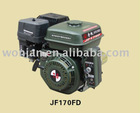- Contact Person : Mr. MOTORCYCLE WONJAN
- Company Name : Chongqing Wonjan Motorcycle Mfg Co., Ltd.
- Tel : 86-23-65155282
- Fax : 86-23-65150083
- Address : Chongqing,Chongqing,40 Nanxi Economic Park, Jingkou Town, Shapingba District, Chongqing China
- Country/Region : China
- Zip : 400033
Related Product Searches:supply gasoline engine 2.5HP,High Quality,Gasoline engine, air cooled gasoline engine,JF1E43F
Model | JF1E43F |
Type | Forced-air-cooled,two stroke single cylinder |
Displacement cm3 | 60 |
Bore x stroke (mm x mm) | 43 x 39.6 |
Engine speed | 5500 |
Max. power (HP) | 2.8 |
Rated Power (HP) | 2.5 |
Max. Torque (N.m / pm) | 3.2/4000 |
Starter | Manual |
Ignition | CDI |
Fuel Tank Capacity (L) | 1.5 |
Fuel Comsumption (g/kw.h) | 544 |
Air-clearner | Foam element |
Lubrication.engine oil (L) | - |
Dimension (L x W x H)mm | 355 x300 x335 |
Net weight (kg) | 10 |
Yolanda teaches ou: How Gasoline Engines Work
Gasoline is incredibly powerful stuff. Just a single soda can of it packs enough energy to blast a typical car close to three miles. Not in one huge explosion, of course (that would definitely spill your latte), but in a series of about 13,000 small explosions contained in your . Still plenty impressive, albeit somewhat less dramatic.More than a century of development has gone into making the modern-day automotive a remarkably effective device for converting fuel and air into useful, reliable forward motion. It does this through the miracle of internal combustion; as the name implies, the engine burns fuel in controlled, measured amounts inside of a combustion chamber. (Actually many of them.) This burning fuel mixture makes heat, which causes a powerful expanding force. The engine uses this expanding force to drive the vehicle's wheels.
There are a number of ways to accomplish this, but the most widely used design is the four-stroke reciprocating-piston . The basic power unit of a piston engine is the cylinder. It's a precisely made metal tube that's open at the bottom and sealed at the top by a component called the cylinder head. The cylinder head has an intake valve and an exhaust valve built into it, both of which can be opened on cue by a camshaft. A sparkplug is also screwed into the cylinder head, with its business end pointing into the cylinder below. A close-fitting piston slides up and down in the cylinder, and is connected to the crankshaft with the aptly named connecting rod. So as the crankshaft spins, the piston travels up and down (reciprocates) in the cylinder. Each of these motions is referred to as a stroke, and there are four strokes in a four-stroke engineno surprise there. Metal seals around the sides of the piston (called piston rings) keep the pressure above the piston where it belongs, instead of letting it sneak out between the cylinder and piston and go places it shouldn't. A thin film of oil on all the moving parts keeps them from grinding themselves to bits, while a liquid cooling system carries away the substantial heat that is created during operation.Intake Stroke Let's take a look at each of the four strokes (sometimes called cycles) of a modern . Picture the piston in its uppermost position, almost touching the cylinder head. The small, trapped volume of air between the piston and head is caught in an area called the combustion chamber. If we rotate the crankshaft in ultra slow motion from this point, the piston descends, which increases the space above it. Pressure in the cylinder drops as a result. The intake valve in the cylinder head opens automatically at this point to allow a fresh mixture of air and a controlled amount of fuel to flow from the higher outside atmospheric pressure into the low-pressure area inside the cylinder. The piston reaches the lowest point of its stroke as the intake valve closes, leaving the cylinder full of a mixture of air and fuel. One of the four strokesthe intake strokeis now complete.Compression Stroke As we continue to rotate the crankshaft the same direction, the piston begins to rise in the cylinder. As it does, the pressure in the cylinder increases dramatically until the point at the top of this "compression" stroke where pressure is about ten times more than it was at the bottom of the stroke only a moment before.
supply gasoline engine 2.5HP






